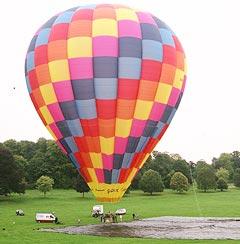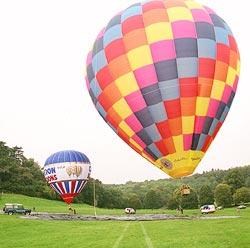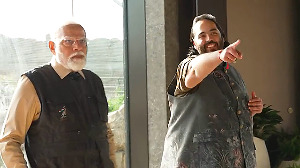On November 26, 2005, industrialist and aviator Vijaypat Singhania will attempt something he never has before. He will try and 'touch the face of God'.
He will -- by undertaking his much awaited adventure called MI-70K -- try and become the first man to fly a hot air balloon to 70,000 feet above sea level (above 21,000 meters). The feat will take place at Mumbai's Mahalaxmi Race Course, where Singhania will try and defeat the existing world record set by Per Lindstrand. The latter managed it way back in June, 1988, in Texas, reaching a height of 64,997 feet (19,811 metres).
 Rising to new heights isn't a new thing for Singhania, who has been an aviator for four decades with flying experience of over 5000 hours.
Rising to new heights isn't a new thing for Singhania, who has been an aviator for four decades with flying experience of over 5000 hours.
"I have been adventurous all my life," he admits, "and have always wanted to do something to contribute to the glory of India. It has been like a baptism through fire all the while, where a small dream turned into a wish, then a craving, and now, with the blessings of God, will finally turn into reality."
Preparations for the flight
As part of his extensive planning, Singhania began learning ballooning in January 2005 in Mondovi, Italy. After passing the CAA license examinations for all ground subjects and flying, he set about gaining experience and acquiring specialized knowledge from the best authorities in the field.
He also undertook practice flying sessions in Palghar, followed by another series of flights in Jalgaon and Mount Abu before the monsoon set in. Recently, he has been testing intensively at Sinnar district, near Shirdi.
In the interim, on June 13, 2005, he established the Indian altitude record of flying in a hot air balloon to a height of 28,200 ft from a village west of Ahmedabad. This, in spite of the scorching heat. When not flying, he has been evaluating and testing his equipment, specially designed for this purpose. He also follows a strict health regime and has lost a lot of weight to make himself physically fit.
Technical team
Considering how demanding the mission is, Singhania has brought on board the world's best authorities. The technical aspect of project MI-70K is being handled by Andy Elson and Colin Prescot, experts from the Flying Picture Company. They have assembled detailed training sessions for Singhania, including 'extreme ballooning' flights, a session in pressure chambers, and stints within the claustrophobic mock-up of a pressurized cabin all to carry Singhania where no hot-air balloon pilot has been before. Andy and Colin have been charged with the responsibility of designing and fabricating the capsule, envelope and burners.
The machine
The equipment, imported from London, is being set by up by the technical team. Experts have been studying and recording weather conditions for every 1000 feet of atmosphere for the past 10 years, day-by-day, minute-by-minute and hour-by-hour. The size of the balloon, date and time of ascent has been decided on the basis of this analysis.
 Singhania's balloon consists of a pressurized and insulated capsule called a 'Gondola' (a welded aluminium single skin pressure vessel made up of commercial grade aluminium, normally used for aeroplanes).
Singhania's balloon consists of a pressurized and insulated capsule called a 'Gondola' (a welded aluminium single skin pressure vessel made up of commercial grade aluminium, normally used for aeroplanes).
The balloon, called Envelope and designed by Don Cameron, is around 160 feet high (approximately equivalent to the height of a 22-storey high building). It is made of 67,250 square feet of specially made light nylon, allowing it to gain altitude without much difficulty. The balloon will be inflated by blowing air into it using portable fans. It will take about 2.5 hours to reach its full size. It is also designed to be rip-proof, and the capacity of the air inside will be 80,000 kilograms (80 tonnes) .
There are 18 burners of different capacity and design. The capsule will be equipped with three fuel tanks, two filled with kerosene and one with propane. The weight of the balloon (including gondola, the envelope, 18 burners and other apparatus) is around 1,820 kilograms. The capsule is also equipped with necessary safety devices, should Singhania be forced to abort his mission. It is also fitted with state-of-the-art instrumentation and control systems for navigation.
To determine what altitude the balloon actually attains, a sealed barometer approved by Federation Aeronautique Internationale (FAI) is installed both outside and inside the capsule. On landing, this barometer will indicate the height reached and will determine the entry of a record in the Guinness Book.
The Flight
The balloon is scheduled to take-off at around 7:00am, soon after sunrise. A control room is being set up to monitor the mission. It will be manned by a flight director, a trajectory director, air-traffic controller and other officials from the Tata Institute of Fundamental Research (TIFR). This team will be constantly in touch with Singhania through a VHF radio, transponder, satellite phones and Global Positioning System (GPS) attached to the capsule. The Indian Army and Indian Air Force will also be on standby.
The flight is expected to take around five hours (time taken to reach 70,000 feet: 3.5 hours; time taken to descend: 1.5 hours). The descent depends entirely upon wind conditions and, according to predictions of the technical team, Singhania will land in an area between Nashik and Sangamner.
The present record holder Per Lindstrand is believed to have said that his record cannot be broken due to the technical difficulties of operating in that rarified atmosphere, where one is virtually on the fringes of space. The atmospheric pressure at sea level is 1,013.2 mbs (millibar per second). At 70,000 feet, it is 40 mbs, with the temperature being around -95 degrees celsius. Naturally, breathing normally will be difficult. Also, if one were to be exposed to the elements even briefly, the human blood would boil.
Singhania believes that only an Indian can break the record. National pride and the spirit of true adventure have prompted him to attempt it in his home city, Mumbai. Attempting it elsewhere would have been easier and cheaper, but that is not an option he ever considered.
To him, all we can say is God speed.







 © 2025
© 2025